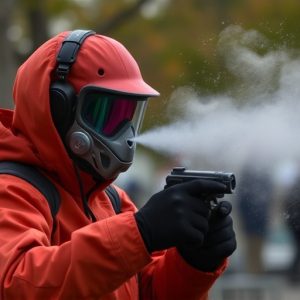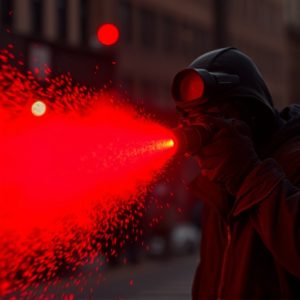Decoding Pepper Spray’s Impact: Mechanisms, Risks, and Alternatives
Pepper spray is a non-lethal self-defense tool containing capsaicin from chili peppers, designed to…….
Pepper spray is a non-lethal self-defense tool containing capsaicin from chili peppers, designed to temporarily disable an assailant by causing severe pain and irritation. It can cause immediate burning sensations in the eyes, skin, or respiratory system, leading to tears, eye closure, and difficulty breathing. While it does not result in permanent blindness, the intense effects on mucous membranes can temporarily impair vision and breathing, incapacitating the attacker. The degree of visual impairment from pepper spray depends on factors like concentration, pattern of dissemination, and duration of exposure; high-strength formulations used by law enforcement or for personal protection are more potent than those meant for signaling or animal deterrence. For self-defense, sprays with at least 10% major capsaicinoids are effective. The fine mist of pepper spray can cover a broader area and last longer, potentially causing a temporary state of blindness or significant visual impairment. Users must understand the tool's impact, legal use, and proper handling to employ it effectively and safely. It is essential to comply with local regulations regarding pepper spray's possession and use to avoid legal consequences. Can pepper spray blind you? Yes, it can induce a temporary form of blindness through intense irritation, making it a potent tool for self-defense when used correctly and legally. Alternative non-lethal defense tools like stun guns, self-defense flashlights, personal alarms, and defensive sprays using inert powders or foams are also available for those seeking safer options.
Peerless in its defensive capabilities, pepper spray remains a widely utilized self-defense tool. Its potent formulation of capsaicin, known for its inflammatory effects, can lead to temporary visual impairment, raising questions about whether it can cause blindness. This article delves into the mechanics behind pepper spray, exploring its immediate impact and the factors that heighten visual impairment risks. We will assess the likelihood of temporary blindness from its use, compare it with alternative personal safety devices, and navigate the complex legal framework surrounding its deployment. Understanding these aspects is crucial for anyone considering pepper spray as a form of protection.
Understanding Pepper Spray: Mechanisms and Effects
Pepper spray, a type of non-lethal self-defense tool, is a form of capsaicin-based chemical spray which can temporarily incapacitate an assailant. The primary active ingredient in pepper spray, capsaicin, is derived from chili peppers and induces a strong irritant effect upon contact with the eyes, skin, or respiratory system. When deployed, it causes intense pain and burning sensations, which can lead to tears, involuntary eye closure, and difficulty in breathing. The spray’s effects are immediate, often within seconds of exposure, and can last for up to 45 minutes, depending on the concentration of the active ingredients and environmental factors like wind and humidity.
Understanding the mechanics of how pepper spray works is crucial for its effective use and for addressing concerns such as “Can pepper spray blind you?” While it does not cause permanent blindness, the intense irritation can temporarily impair vision. The eyes’ mucous membranes are highly sensitive, and capsaicin rapidly degrades the visual clarity by causing the eyelids to swell shut and the tears to flow, which can obscure vision. Similarly, inhalation of the spray can cause coughing and difficulty in breathing, further compromising an attacker’s ability to see or react effectively. It is important for users to be aware of the potential effects and to use pepper spray as a deterrent and last resort for personal safety. Proper training and understanding of its limitations are essential for safe and effective deployment.
The Potency of Pepper Spray: Factors Influencing Visual Impairment
Pepper spray, a non-lethal self-defense tool, is formulated with capsaicinoids derived from chili peppers, which can cause significant irritation upon contact with mucous membranes. The potency of pepper spray in inducing visual impairment is influenced by several factors, including the concentration of the active ingredients, the spray pattern, and the duration of exposure. High-strength pepper sprays, often marketed for law enforcement or personal defense with greater incapacitating potential, can cause more severe effects than those designed for signaling or animal deterrence. The concentration of oleoresin capsicum (OC) in pepper spray directly correlates with its ability to induce pain and temporarily blind an assailant. Typically, sprays containing at least 10% major capsaicinoids are considered effective for self-defense. Additionally, the spray’s pattern affects how it disseminates in the air; a finer mist can travel further and potentially cover an area more extensively, increasing the likelihood of incapacitation. The effects of pepper spray on vision are usually temporary, but they can be profound, leading to an inability to see for several minutes. Factors such as wind conditions, environmental elements, and the proximity between the user and the target can all influence the effectiveness of the spray. It’s important to understand that while pepper spray can indeed cause a state akin to temporary blindness, it is not designed to inflict harm but rather to provide a deterrent during altercations, allowing individuals to escape dangerous situations. Users should be well-informed about the product they are using, including its limitations and legal implications, to ensure safe handling and effective use in self-defense scenarios.
Assessing the Risk: Can Pepper Spray Cause Temporary Blindness?
Pepper spray, a common self-defense tool, is designed to incapacitate an assailant by causing intense irritation to the eyes, skin, and respiratory system. The active ingredient in pepper sprays, capsaicinoid, simulates the intense pain induced by chili peppers. When deployed, it can lead to temporary blindness, not because it damages the eye but due to the extreme discomfort and pain that make it impossible for the eyes to open or for vision to be processed effectively. This phenomenon typically lasts from 15 to 45 minutes, allowing for a window of opportunity for escape or for authorities to intervene. It’s important to note that the severity of effects can vary depending on factors such as wind conditions, proximity to the target, and the specific formulation of the spray. In some instances, individuals with certain eye conditions might experience prolonged effects. Therefore, while pepper spray is a non-lethal defense mechanism, it should be used responsibly with an understanding of its impact and potential consequences on both attackers and bystanders.
Personal Safety Devices: Alternatives to Pepper Spray for Self-Defense
When it comes to personal safety devices, pepper spray is a widely recognized option for self-defense. However, concerns about its efficacy and potential side effects, such as the question of “Can pepper spray blind you?” have led many individuals to explore alternatives. Non-lethal self-defense tools offer a range of viable options that can provide protection without the risks associated with pepper spray. For instance, stun guns are electrically charged devices capable of incapacitating an attacker by delivering a high-voltage shock, which can be an effective deterrent. Sturdy flashlights designed for self-defense combine bright illumination with a striking beam and a shock feature to subdue an aggressor. Additionally, personal alarms emit a loud sound that can disorient an attacker and draw attention to your location, ensuring help is on the way. Another alternative is the use of defensive sprays that deploy an inert powder or foam, which can immobilize an assailant without causing permanent harm. These devices are designed to be user-friendly and legal for civilian use in most jurisdictions, offering a safe and effective means of self-defense. When selecting an alternative to pepper spray, it is crucial to consider the legal implications, your comfort with using the device, and the specific circumstances under which you may need to employ it for personal safety.
Legal Considerations and Regulations Surrounding Pepper Spray Use
In the realm of personal defense mechanisms, pepper spray has emerged as a widely accepted tool due to its efficacy and relative legality. However, the use of such self-defense sprays is subject to stringent legal considerations and regulations that vary by jurisdiction. It is imperative for potential users to understand that while pepper spray is designed to incapacitate an assailant through intense irritation caused by its active ingredient capsaicin, it can also lead to temporary blindness if directed towards a person’s eyes. This potential to cause temporary visual impairment underscores the critical importance of responsible use and proper handling. Legal frameworks across different countries and states have been established to govern the acquisition, possession, and deployment of pepper sprays. These regulations often dictate the strength and type of spray allowed, as well as stipulate who may legally purchase and carry such an item. For instance, laws may restrict the sale of certain types of pepper sprays to minors or limit the quantity that can be carried at any given time. Users must also adhere to specific training guidelines, if mandated by law, to ensure the spray is used in self-defense situations and not for unnecessary or harmful purposes. Adherence to these legal considerations is non-negotiable, as violations can lead to serious legal consequences, including fines and imprisonment. Therefore, potential users should familiarize themselves with local laws and regulations before considering pepper spray as a component of their personal safety plan. Comprehensive knowledge of the legal landscape ensures that the use of pepper spray remains both effective as a deterrent and compliant with the law.


